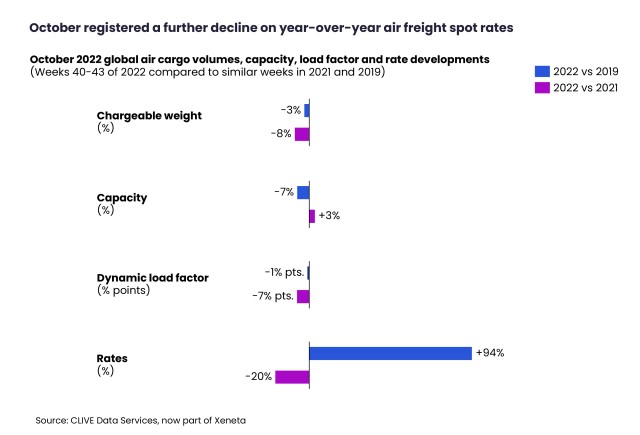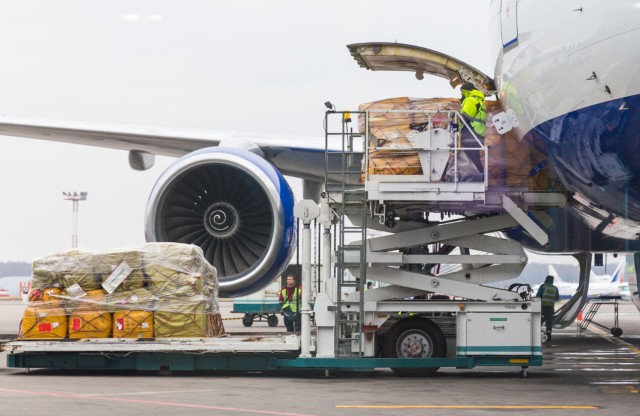Christmas didn’t come early for the global air cargo industry as volumes declined -8% year-over-year in October and provided no current signals to indicate an upturn in 2023, as year-over-year demand fell for the eighth consecutive month, according to new weekly market data from industry analysts CLIVE Data Services, part of Xeneta.
The drop in demand, measured in chargeable weight, was also -3% below the pre-pandemic level in 2019.
Compared to last year’s levels, global air cargo capacity continued to recover in October but at a slower pace and remained -7% below the pre-covid 2019 level. This contributed to a more subdued ‘dynamic loadfactor,’ CLIVE’s measurement of airline performance based on both the volume and weight perspectives of cargo flown and available capacity. As falling demand meets rising capacity, load factors have been declining over the past 18 months. In October, the 61% dynamic loadfactor was -7% pts and -1% pts in comparison to 2021 and 2019 respectively.
October saw a second consecutive month of lower global airfreight spot rates below last year’s level. The slight uptick in week 3 was mainly caused by the rise of special cargo freight rates, while general rates continued their downward trend.

“We are six weeks away from Christmas and there is no indication there will be a peak. Demand worsened in October over the -5% reduction we reported in September, but this is not likely to surprise the market given the global economic outlook, although it’s clear that rates remain at a higher level than some observers would have expected in the current conditions. Airfreight is certainly not currently suffering the decline of ocean, where Xeneta has recorded rate drops of 60%-70% in the last nine months. Ocean freight is responding to the market conditions much faster than air is and normalising quickly from a rates point of view. The outlook for air cargo remains uncertain. We don’t see a pressure on capacity, and we don’t see an increase in rates,” said Niall van de Wouw, Chief Airfreight Officer at Xeneta.
Airfreight rates on top volume corridors from Asia to Europe and Asia to the US continued to fall in October, while general rates fell more substantially on inbound US corridor routes than inbound Europe. This is attributed to added costs for EU routes, due to the closure of Russian airspace and lower spending by US consumers.
Europe to US airfreight spot rates stood at USD 3.11 per kg in October, down 27% from the 2021 level, while Asia to Europe spot rates fell USD 5.09 per kg, down 25% year-over-year. Asia to US registered the sharpest decline among the three top volume corridors, with the average spot rate down 45% from October last year to USD 5.87 per kg.
In comparison, the Latin America to US corridor showed more resilience to market headwinds, although its airfreight spot rate slid 11% to USD 1.38 per kg in October.
Shippers, however, may not be seeing long-term gains from falling airfreight rates right away, Niall van de Wouw says: “There is a lot of uncertainty, so this is not a period where shippers will get an ‘attractive’ deal for the next year or two years, they will get lower rates for the next one to two quarters, but who knows what will happen beyond that.”






